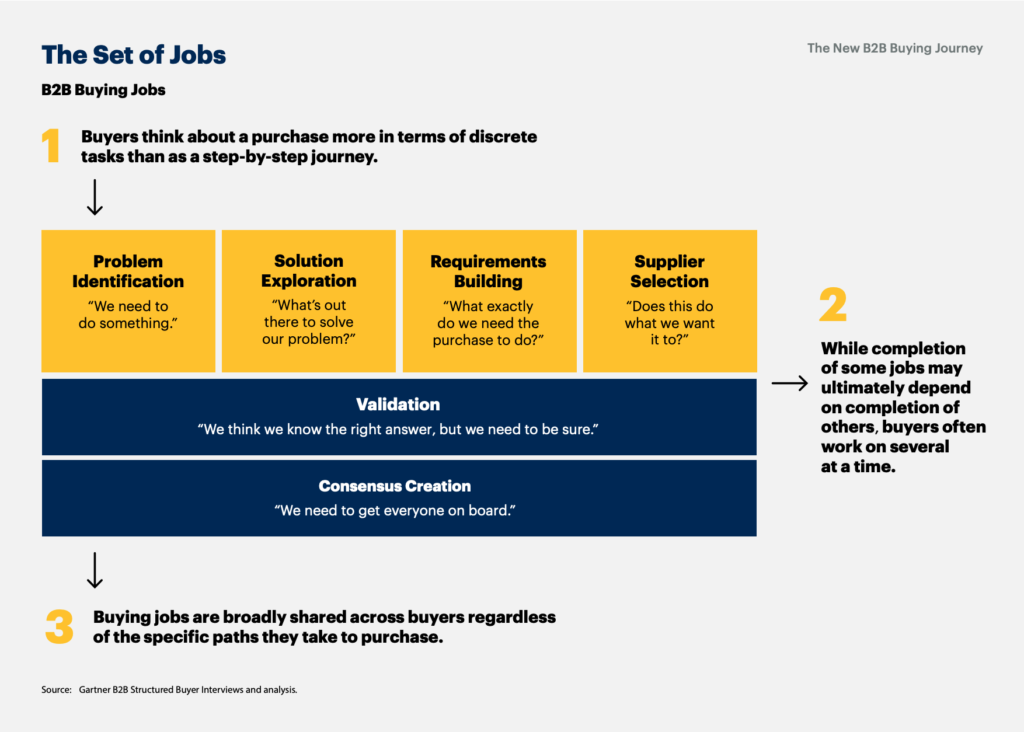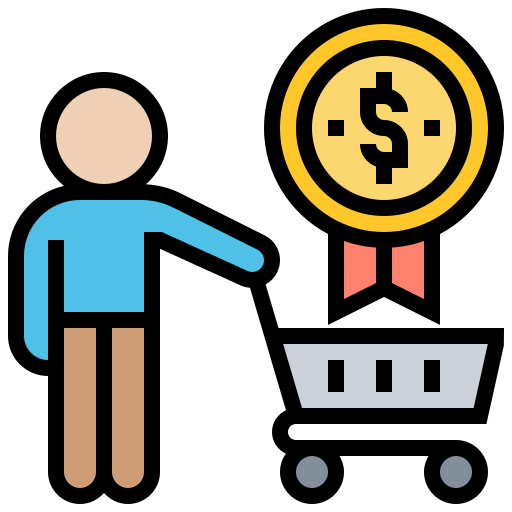To sell to people, you have to be selling something they actually want. The more useful and valuable your product/service, the more sales you make.
But you can’t just expect people to buy your product because they want it — because they might not even know they want it yet!
In this post, we’re going to be tackling what motivates people to buy. (Hint: it’s not demographics.)
Read on to discover:
- Why people buy
- How to get your buyers’ attention
- How to earn your buyers’ trust
- How to understand and capitalize on your buyers’ motivations
- All of the tips you’ll need to know in between to help you start making more sales.
Let’s get started with our first pressing question…
Table of Contents
Can you define your buyers by demographics?

Nope! Demographics don’t buy — people with problems do.
Two people may demographically appear to be the same, but their shopping habits and personal motivations are probably drastically different.
That’s why defining your ideal audience by demographics alone isn’t a good idea. You may be targeting the wrong people and excluding your true ideal customers.
Case in point…

Why people buy: it all starts with a triggering event
Let’s level set: a triggering event is when someone goes from being unaware they have a problem to figuring out that they have a pain point.
Here’s an example: you keep getting really tired at work around 3 pm.
At first you don’t know what is causing it. Maybe you need to get more sleep — or maybe you need to start going to the gym during your lunch break.
This is your triggering event. You’re starting to be able to name your problem: you’re always tired at work during the afternoons but you don’t know what you are going to do about it.
This is where customer education really plays a role. The customer may start typing things into a search engine like “tired at work,” or “what causes the afternoon slump.”
This is where you can start to get in front of your customer. But don’t start selling yet! At this stage, you need to be educating. Help the customer name their problem and provide some solutions for the customer to try out (including what you are selling).
What are trigger events?
Trigger events can be:
- Situational (e.g. getting engaged, getting a divorce, your oven breaks, losing a job, hating your boss, getting a new job, rent is doubling so you have to move, etc.)
- Biological (e.g. being cold, hungry, pregnant, aging, etc.)
- Emotional (e.g. feeling FOMO, insecure, depressed, etc.)
- Social (e.g. seeking status or recognition, argument with your boss, a friend going through something similar, etc.)

Something triggered all of these instances, whether an event, emotion, or social change, and now your prospective buyer recognizes that they have a job to do — and so the buying journey begins!
And your buyer may not even be aware they are on this journey.

B2B Marketing: Your buyers have a job to do
If you’re in the B2B marketing space, this section is for you.
Buyers need to complete a set of tasks to get their job of making a purchase done. These buyers are ultimately trying to solve a problem for their organization.
As B2B Marketers, it’s our job to understand how to best help prospective customers advance through their complex purchase decisions. Gartner research identified 6 B2B buying “jobs” that customers must complete to their satisfaction in order to successfully finalize a purchase.

- Problem identification: “We need to do something.”
- Solution exploration: “What’s out there to solve our problem?”
- Requirements building: “What exactly do we need the purchase to do?”
- Supplier selection: “Does this do what we want it to do?”
- Validation: “We think we know the right answer, but we need to be sure.”
- Consensus creation: “We need to get everyone on board.”
B2B Marketers and companies need to focus on providing customers with information that is specifically designed to help them complete their buying jobs. Customers reward suppliers that make buying easier.
Newsletter Sign up!
Get our best content on digital marketing in your inbox 2 times a month

Why to use retargeting ads
If the customer decides to click over to your website while doing their research, this enables your Facebook and LinkedIn pixels to activate, which means you can now start to re-message this prospect with ads that help move them down the funnel.
This is part of the reason why retargeting ads can have much higher clickthrough and conversion rates than standard display ads.
Seeing your brand everywhere builds familiarity, which often leads to an instinctive trust in your business. You’re creating cognitive biases towards your business!
There will be a moment where your buyer goes from unsure they have a problem or issue to looking for a solution to fix their problem — this is the marketing sweet spot.
Your product or service needs to show how you can solve their pain points or problems. And, in order to do that effectively, you need to help educate your prospects so they can become better buyers.
Why customers can’t actually tell you why they buy

Most people are not present enough to be able to name why they are doing what they are doing. This is one of the challenges of asking your customers straight out what drove them to make the decision to buy.
When asking your customers why they bought your product/service, you may get some great directional insights — but what truly motivated them may never be known.
And the customer may never realize that they were feeling jealous of their neighbor (the one with a hot wife, nicer house, and now nicer car too) when they went out to the car dealership and bought a new BMW.
The customer felt his status was being threatened so he needed to “peacock.” But, in his own words, he would probably say he “just needed a change.”
In reality, the trigger event was emotion: he was feeling insecure.
So here’s the golden formula:
No trigger event = no purchase.
No one buys for the sake of buying!
How to get your buyer’s attention
There aren’t any official figures yet, but in 2021, the average person is now estimated to encounter between 6,000 to 10,000 ads every single day.
We’ve all gotten really good at ignoring marketing messages. If we didn’t, we would be so overwhelmed trying to process 10,000 ads a day on top of our daily lives.
There’s a name for this mental trick: banner blindness. (And we all have it!)

Start understanding your buyers
Wish you understood your buyers better but don’t know where to start? We’d love to help you define your buyers’ pain points, trigger events, and buying journeys so you can start making more sales.
So what do buyers pay attention to? Solutions to their problems.
Buyers searching for solutions to their problems have their reticular activated.
Here’s the best way to explain your reticular: if someone close to you gets a new red car, you now start to notice red cars everywhere. Or if you get pregnant, you start to notice so many other people who are pregnant.
Our brains are super complex and they only process a small number of inputs around us. We have to organize the information around us and our reticular activating system helps us do that.
Once a buyer experiences a trigger event, they start passively noticing possible solutions — their reticular has been activated. And your buyer may even start to actively explore his/her options.
Why the buyer’s journey is messy
The process of making a purchase is rarely straightforward. It’s a cobbled-together mess of steps that are hard for marketers to attribute what specific channel truly made an impact.
As Google says, it’s just plain messy.
Check out all the ways your prospective buyers can bounce around!

Buyers will often explore a variety of different options before they begin actively looking for a solution like yours.
Think back to the “tired at work” example: the buyer may sign up for a 10 week package at a gym, start going to bed earlier, and give those a month or two to work.
If those don’t seem to be working, the buyer may continue their research by reading articles about what can cause the afternoon slump and may happen upon an online ad for a green tea energy drink.
During this time, the buyer may be getting closer to saying… “I think I just need a quick, natural energy drink!”
And, in this situation, you sell green tea energy drinks. The customer has been able to officially name their problem and what will solve their problem. This means they are now at the purchasing stage.
In marketing, this is considered to be the bottom of the funnel stage, and bidding on keywords like “energy drink” or “best natural energy drink” can be very expensive.
Newsletter Sign up!
Get our best content on digital marketing in your inbox 2 times a month

How to earn your prospect’s trust during their journey
If you are able to pinpoint your customers’ buying triggers, you can get in front of prospects before the competition and earn their trust.
Studies show that if you can get your brand in front of a prospect multiple times throughout their journey, you have a much higher chance of being considered when it’s time to make the purchase.
Once your buyer has experienced the initial trigger event, their decision timeline may be slowed down or speeded up depending on various internal and external factors.
In the buyer’s decision process, factors that slow down or speed up the buyer’s decision are called catalysts.
Going back to the energy drink example, seeing an article that you can get addicted to energy drinks may slow down the buyer on their journey.
On the other hand, discovering that there are natural green tea energy drinks (and that green tea is a calming, non-addictive energy solution) may speed up the buyer’s journey.
Someone won’t buy an energy drink subscription just because there’s a sale on it for President’s Day — but this can help to speed up the buyer’s cycle.
Said another way…
Sales do not create demand. But they can help you capture it.
How to understand and capitalize on your buyers’ motivations
So here’s the big question: how can you apply all of this to sell more?
1. Interview your buyers (current, prospective, and lost)
To begin understanding more about your buyers, it’s best to go straight to the source. Ask your buyers why they do what they do! And by “buyers,” we don’t just mean people who have already bought your product/service. Make sure to dedicate time to finding and reaching out to both prospective buyers and lost buyers.
Why not just interview your current customers? It could skew your data and prevent you from seeing the clearest picture of your buyers’ motivations.
Here’s the benefits of interviewing all three kinds of buyers:
- Current Customers: Tell you exactly why they bought your product and for what reason
- Prospective Customers: Tell you why they’re thinking of buying and potential hang-ups/reservations
- Lost Customers: Tell you why they were considering your product and what made them say “no.”
How to go about interviewing? Here’s 5 easy steps:
- Identify interview prospects
- Request an interview
- Schedule the interview
- Conduct the interview
- Summarize key findings
And it’s not just enough to do the interviews — make sure you evaluate the insights you’ve aggregated in your key findings and consider implementing changes to your process.
Worried about people saying yes? Consider incentivizing them by offering a $25 Amazon gift card (or whatever you think would be valuable to them!).
2. Discover your customers’ buying triggers
This is where you get down in the trenches to find out what really causes your customers to buy. We’re talking about some James Bond level spy work. Scan all of the most frequented internet forums (like Amazon, Facebook, Reddit, Twitter, etc.) to get a better feel for their language and how they approach their problems. Another great way to discover your customers’ buying triggers is to interview/conduct surveys among your past buyers.
Consider asking: “So, what was going on in your life that made you realize you may need to find a solution?”
3. Track your customers’ buying triggers
Great — now that you’ve unearthed your customers’ buying triggers, you can set up tracking and even be alerted when someone may be in the buying journey.
You can set up Google Alerts for your business’s relevant keywords/phrases or use Groouply to track keywords in Facebook groups.
For B2B, tools like LeadSift or LinkedIn Navigator can help you to identify prospects who have signaled intent to buy.
4. Create timely campaigns and content
One of the best parts of nailing down your customers’ buying triggers? You can create custom campaigns that will actually speak to them. Truly understanding your customers’ buying triggers means you don’t have to throw a wide net and hope it catches some prospective buyers.
What does a timely campaign look like? Marketers from meal kit companies did some buyer investigation and discovered that the busy “Back to School” season can be a major trigger event for many parents. What did they do? They sent out mailers to families with school age children in the first week of September. Talk about good timing.
Conclusion
So, what to take away from this?
- Demographics don’t buy — people with problems do.
- All purchases begin with a trigger event. No one buys for the sake of buying!
- It’s hard to get your buyers’ attention — and the buyers’ journey is a messy one.
- The key to getting your buyer’s attention: understanding their buying triggers and creating custom, timely campaigns and content.

Start understanding your buyers
Wish you understood your buyers better but don’t know where to start? We’d love to help you define your buyers’ pain points, trigger events, and buying journeys so you can start making more sales.







